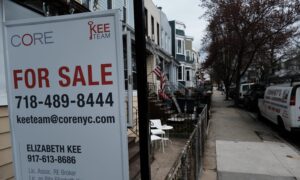
U.S. home mortgage rates soared towards 7 percent this week, pushing away many potential home buyers as affordability pressures for some pushed home ownership further out of reach.
The average rate on the popular 30-year fixed mortgage hit 7.22 percent on July 6, reaching its highest point since November, according data published by to Mortgage News Daily.
Freddie Mac’s report showed a lower surge in the 30-year fixed mortgage rate to 6.81 percent from 6.71 percent the week prior.
“Mortgage rates continued their upward trajectory again this week, rising to the highest rate this year so far,” Freddie Mac said. “This upward trend is being driven by a resilient economy, persistent inflation and a more hawkish tone from the Federal Reserve.”
Mortgage Rates Surge After Comments From Fed
Mortgage rates had already started to rise last week, after signals from Federal Reserve Chairman Jerome Powell suggested that the central bank may start raising interest rates again soon following a pause in June.
Mr. Powell told Congress in June that the central bank has “a long way to go” to bring inflation to its 2 percent goal.
Recently released minutes from the Fed’s last policy meeting further revealed that central bank policymakers favor a more hawkish stance towards future rate increases.
The next policy meeting on whether to raise interest rates is on July 26.
Following an uptick in the 10-year Treasury yield, 30 year mortgage rates rose with the release of the Commerce Department’s report last week, which showed inflation increasing slightly in May following a stronger than expected employment report from Automatic Data Processing, Inc. (ADP).
“The recent spike in mortgage rates pushing rates over 7 percent will further dampen pending and closed sales units,” Emmitt Laffey, CEO Berkshire Hathaway HomeServices, which covers the New York market, told The Epoch Times.
“Pending sales year over year in metro New York are down 15 percent. And with rates over 7 percent, this trend will continue.”
“On the other hand, median home prices year-to-date are level to slightly higher,” Mr. Laffey added.
Non-High End Buyers Edged Out of Market
Higher mortgage rates have once again kept low to medium end buyers from purchasing homes—a problem which has haunted the industry for over a year.
“These high rates combined with low inventory continue to price many potential homebuyers out of the market,” Freddie Mac said.
Year-to-date new listings of available homes are now 20 percent behind last year’s pace.
There were 467,000 single-family homes on the market nationwide for the week ending July 5, which is a 2 percent decrease from last year, according to Altos Research.
At least 385,000 single-family homes were in contract during the same week, 14 percent less than the same week in 2022.
Although the current sales pace appears to have peaked for the year, it appears that 2022 will show sales of 15 percent fewer homes on the market compared with 2022.
During the same period in 2022, inventory was rising between 4 and 6 percent each week.
Only 45.6 percent of new and existing homes sold between January and the end of March were available to households with an income of $96,300, according to the National Association of Home Builders (NAHB) and Wells Fargo Opportunity Index.
Although it was an improvement from the 38.1 percent in the fourth quarter of last year, it remains one of the lowest levels on record for the NAHB.
“Rates are still over a percentage point higher than a year ago, and housing affordability is still a challenge in many parts of the country,” MBA Deputy Chief Economist Joel Kan said in a statement.
Sales Continue to Fall Nationwide
Purchase applications dropped 5 percent on a seasonally adjusted basis for the week ending July 6 and were 22 percent lower than the same week a year ago, according to the Mortgage Bankers Association’s (MBA) latest survey.
At the same time, the MBA’s seasonally adjusted Market Composite Index saw mortgage applications decline 4.4 percent while its refinance Index decreased 4 percent.
“Mortgage applications fell to their lowest level in a month last week as rates for most loan types increased,” Mr. Kan said.
The MBA reported that the average loan size for a purchase application declined to $423,500 in its weekly report, for the lowest level since January 2023.
“This was likely driven by reduced purchase activity in some high-price markets and more activity in some of the lower price tiers as buyers searched for more affordable options,” Mr. Kan said.
Meanwhile, the jump in mortgage rates is hurting housing sales this summer, as many homeowners are dissuaded from listing at this time, keeping the inventory of saleable homes extremely low and purchase prices high.
Jiayi Xu, an economist at Realtor.com, noted that nearly 82 percent of home buyers reported “feeling locked-in by their existing low-rate mortgage, while around 1 in 7 homeowners without a selling plan cited their current low rate as their reason for remaining on the sidelines.”
Most American homeowners currently have mortgages with interest rates below 4 or even below 3 percent after rates hit a record low in 2020, and many have no plans for now to sell and move as they would have to buy at a higher rate.
















































